Digital Nomad Gear Guide
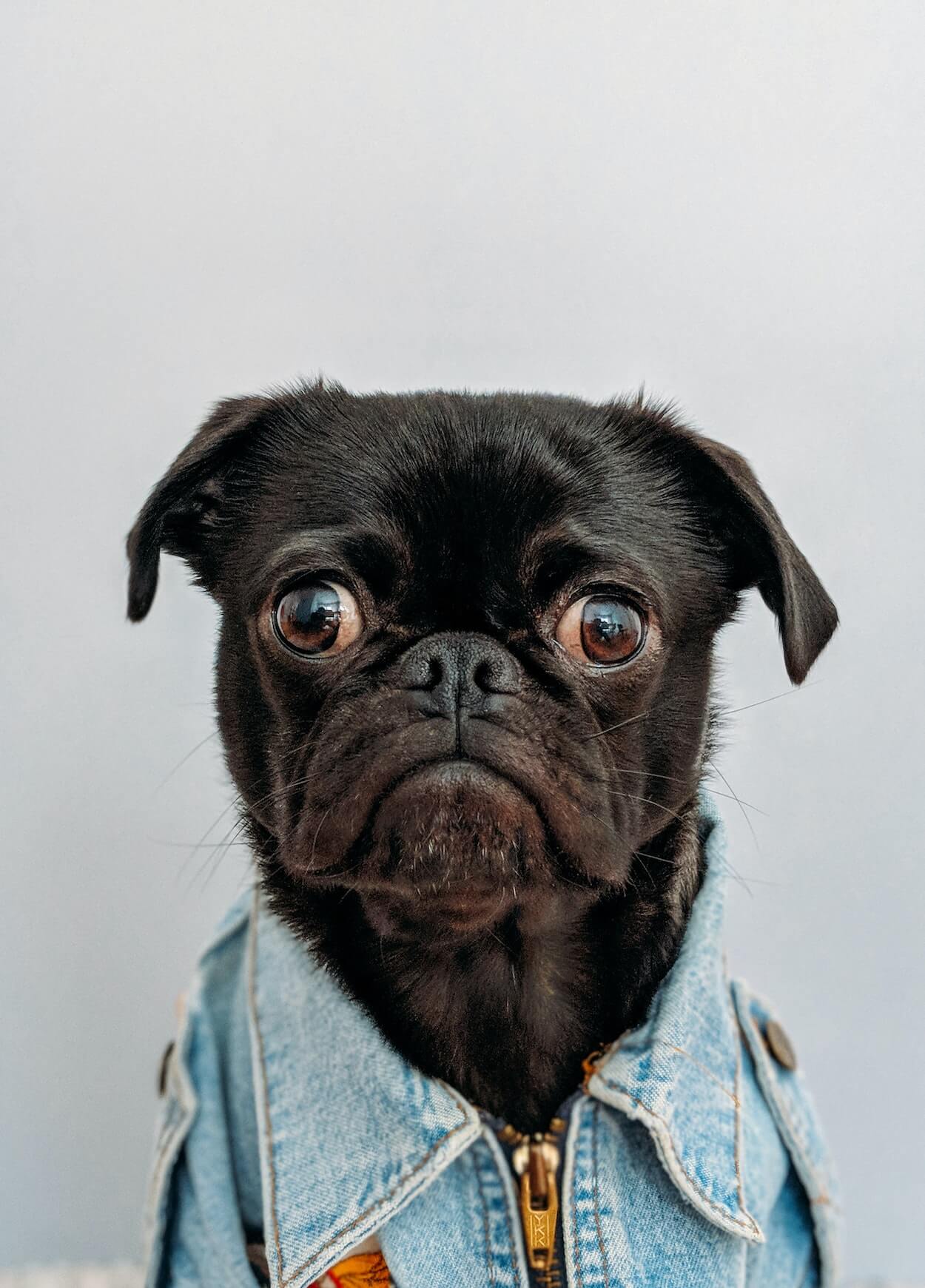
A digital nomad gear guide and packing list. Minimalist travel, packing tips and reviews on travel bags and backpacks, clothing and gear.
I believe gear is not important for a digital nomad. Your resourcefulness and mindset are primary. However, as gear is a frequent topic of enquiry I’ve put together this digital nomad gear guide.
This guide takes into account how you travel, the clothing you wear and gear you use, are personal. One size does not fit all. There are no blanket statements that this or that product is the best. Instead, I offer different perspectives on travel, clothing, and gear. Use this guide as a reference and create a packing list that fits your needs.
This guide contains Amazon Affiliate links. This means that if you click on an Amazon link and buy something, I may earn a (very) small commission, yet you don’t pay any extra, and it’s a simple way to help support NoDesk.
Table of contents
- Minimalist travel
- How to travel like a minimalist
- Packing tips
- Travel bags
- Checked bags
- Hardside, softside and spinner bags
- Duffel bags
- Carry-on bags
- Backpacks
- Shoulder and carry-on bags with spinners
- Daypacks
- Travel Accessories
- Clothing
- Gear
Minimalist travel
These days it’s trendy to be a minimalist. There’s even an international bestselling book on how to tidy up and declutter your home. But, for this guide, we’re only interested to learn how we can use minimalism to make travel better.
What is minimalism? If we had to sum it up in a single sentence, we would say, Minimalism is a tool to rid yourself of life's excess in favor of focusing on what's important—so you can find happiness, fulfilment, and freedom.
I define minimalist travel as one bag travel. You only pack what you need, not what you can fit, into a carry-on size bag. You travel with peace of mind and freedom of movement. There’s no checked bag. No anxiety about what you may have packed or forgotten. No excess baggage fees or problems complying with an airline’s baggage allowance. There’s no stress at the airport check-in desk or fumbling around at the security line.
Minimalist travel helps you simplify travel. You travel with confidence. You don’t anticipate trouble or worry about things that may never happen. You pack light and go fast. Each item you bring has a purpose. You minimise time spent at the airport as there’s no need to check-in a bag, wait at the baggage carousel, or report a lost item. When disruptions occur, you can adjust your travel plans and find alternative routes.
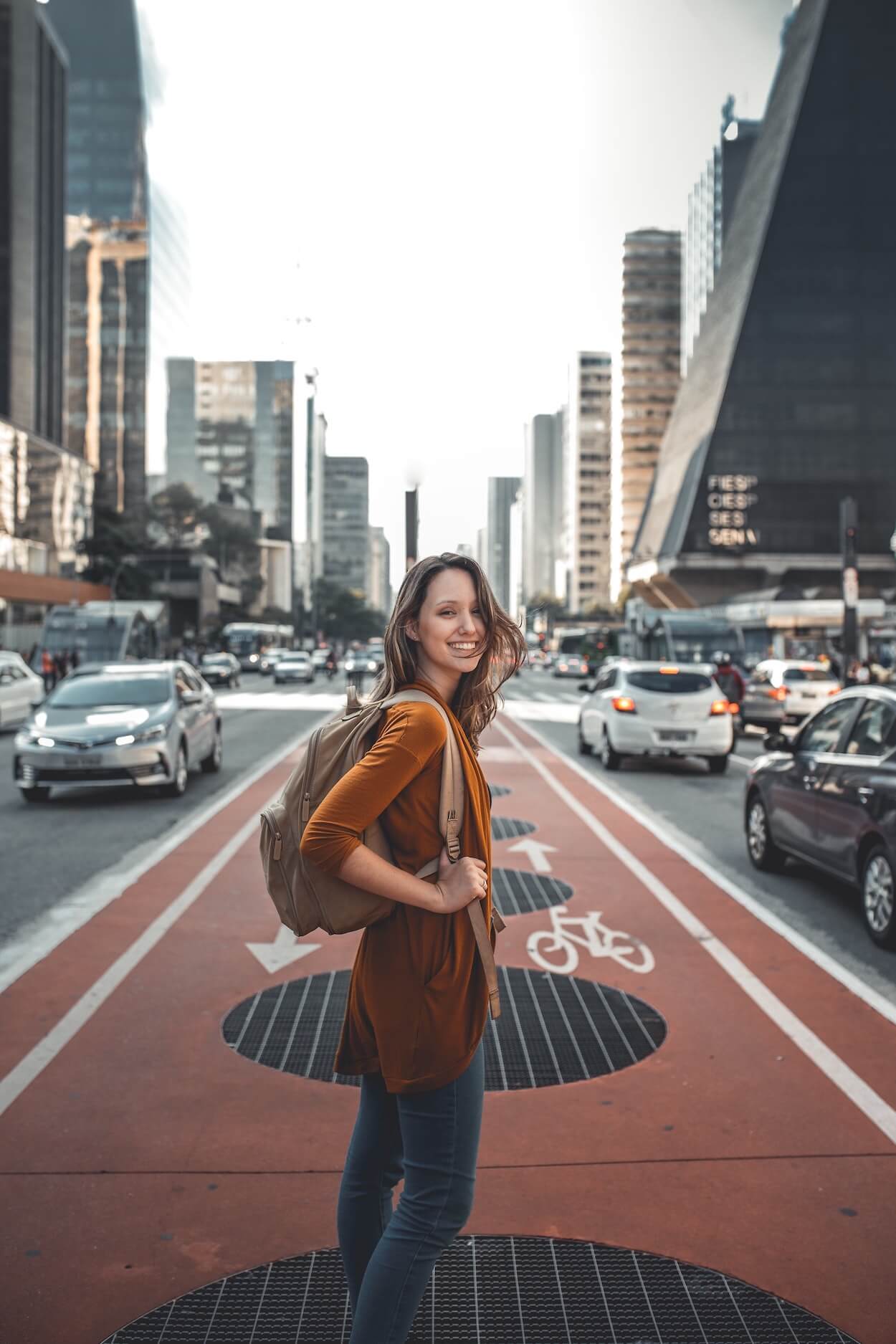
There are situations where one bag travel is not possible, recommended, or desired. But minimalist travel is ultimately about mindset. You may not have the same agility, mobility, and freedom of movement with a suitcase, but you can still travel with confidence, happiness, and peace of mind. Declutter your mind, the way you pack, and avoid anxiety, stress, and worry when you travel.
The best part about traveling is the forced minimalism. My life at home, as it has evolved, is quite complex and full of stuff. On the road I'm reduced to what I carry in a small backpack and hand bag — clutter becomes a physical burden. I really enjoy this simplicity as it helps me focus. One of my favorite things to watch as a friend or colleague travels more is how their bag gets smaller and smaller with each trip.
How to travel like a minimalist
This section offers practical tips on how to pack light and travel like a minimalist.
Start with a carry-on size bag.
This will force you to make do with fewer items and be selective with what you pack. Take out all the items you want to bring and ask yourself, “Do I really need this?” Repeat this process until you are left with the items you actually need.
Pack the remaining items into your carry-on bag. Don’t be surprised if you put away more than half of the items you initially took out.
Use the same process even if you need to travel with a bag that you will check-in.
Packing tips
Create a packing list before you leave.
When you return from your travels, review what you brought and used, and note down what you would do differently next time.
Your packing list will be similar whether you travel for a week or month.
- Bring clothes you can mix and match to create different outfits instead of items you will only wear once.
- Bring clothes that are functional and you can use in different settings, such as a pair of shorts that you can use at the beach, gym or around town. The same applies to shoes.
- Think in terms of layers. Layers offer more flexibility in unpredictable and cold weather compared to heavy-duty clothing.
- Wear your outer-layers when you travel.
- You can pack your clothes in different ways to save space. I suggest a combination of rolling, folding, and the use of packing organisers. Be creative: fill shoes with socks, fold clothes within clothes, etc.
- You don’t need that many shoes. Apart from the shoes you wear during travel, a pair of flip-flops is usually enough.
- Set aside a small travel fund for items you don’t pack, but can instead buy on location, such as toiletries, to minimise the size and weight of your carry-on bag.
- There are no standard carry-on bag size and weight limits. Make sure you’re aware of your airline’s restrictions. The International Air Transport Association has set guidelines on bag size, but these are not mandatory for airlines to follow.
- Optional. Bring a daypack that fits within your carry-on bag. At your destination, use the daypack for any activity that involves more gear than you can carry in your pockets. A daypack is also a safeguard if you are required to check-in your carry-on bag at the airport. Remove your daypack, and only pack what you don’t want to check-in.
Travel bags
You have four options to consider when deciding on a travel bag: a checked bag, duffel bag, backpack, and carry-on bag.
Although different in type, there are certain factors to consider that apply to all options. These include:
- Appearance, brand, and quality;
- Ease of carry;
- Ease of use;
- Features and functionality;
- Material and durability; and
- Size and weight.
As with the items you pack, you want a lightweight bag. If your carry-on bag weighs empty 3.5 kg and the airline limit is 10 kg, you’ve already lost 35% of the allowed weight. The same applies to luggage. You will often face a tradeoff between weight and cost. Lightweight, technical materials are expensive.
The next factor to consider is size. The more space you have, the more stuff you will pack. As a digital nomad, more space is not always better. Be restrictive. If your carry-on or luggage comes in different sizes, look at the features and proportions to determine which size fits you best. Make sure your bag is carry-on or check-in compliant.
The material your bag is made of is important and something you need to consider. Do you need a pack that is waterproof, highly durable, ultra-lightweight? Beware, some materials, although highly durable, are abrasive and can damage or pile your clothes.
The next factors to consider are ease of use, and the features and functionality of the bag.
Can you access and pack your gear with ease? Does the bag open flat, as a clamshell or from the top? Are there internal pockets and dividers in the main compartment, or is it only a large compartment? Does your bag have an internal frame, or is it frameless? Does your carry-on have a separate laptop compartment? In terms of functionality, can you use your bag for more than travel, perhaps for work or the gym?
Another factor you need to consider is the ease of carry. A bag with wheels is more convenient, but if you travel to a location with mostly unpaved streets or rugged terrain, it isn’t. A backpack offers the most flexibility in terms of movement. Assess the ways a bag can be carried and the method of carry which works best for you.
Brand, build quality, and appearance are also factors to consider. Some packs draw attention. Others make you look like a hitchhiker or tourist. In some locations, blending in with the local population is preferred and requires a more discreet bag. Build quality is important, especially if you plan to buy a bag for life. Some manufacturers offer lifetime warranties.
Many of the bags I suggest for minimalist travel are expensive, but with care, they can last many years. There’s a certain nostalgia associated with travelling the world with the same bag.
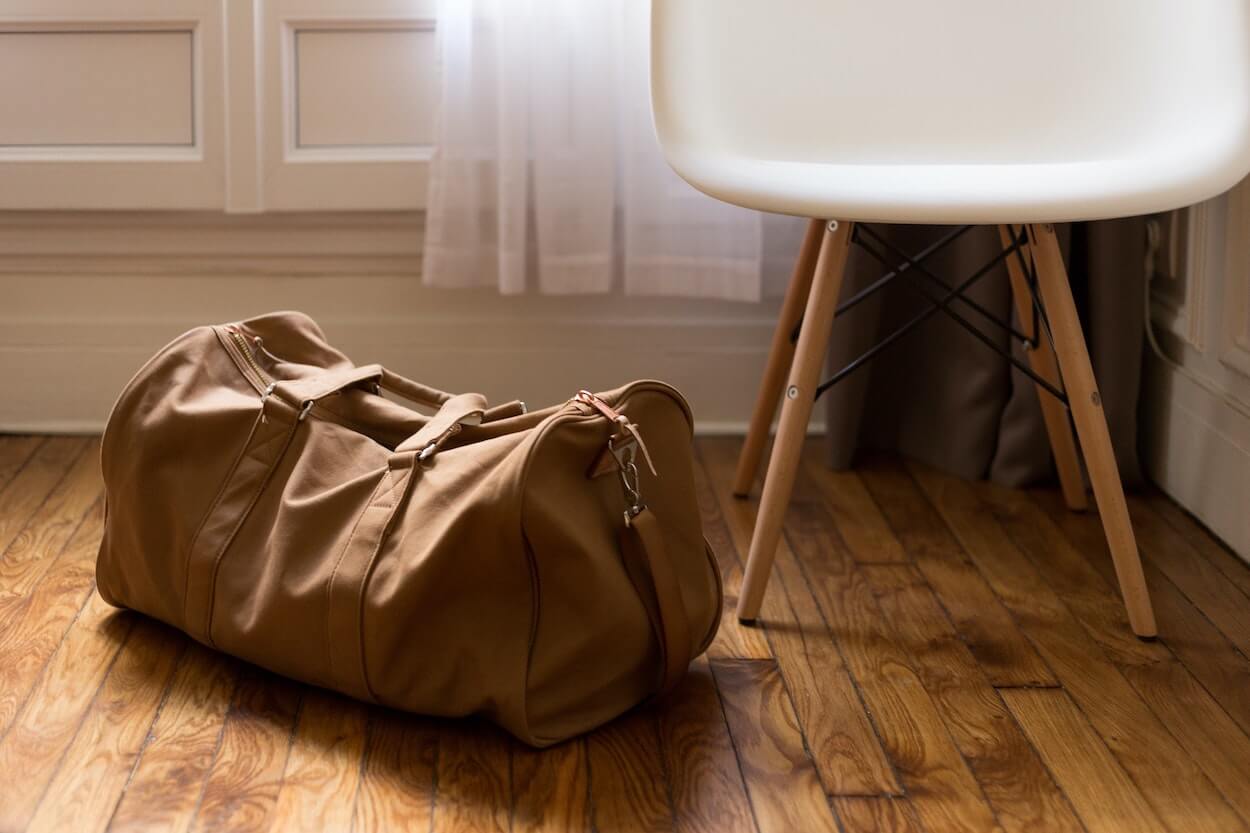
But at the end of the day, it’s just a bag.
Checked bags
Hardside, softside and spinner bags
A bag with spinners (wheels) is the most convenient for travel. Make sure that the retractable handle and spinners are sturdy, and the bag can be rolled in an upright position in multiple directions. There’ll be times when you need to carry your bag, so consider the ease of carry.
Most models open as a clamshell. This makes packing easier as you have two compartments, but when open, the bag will take up more space. Some models offer an internal organisational system, which makes packing easier. Checked bags will take space to store when not in use, and don’t have much use except for travel. Expect dents and scratches to your bag.
Brands to consider are Briggs & Riley, Rimowa, Samsonite, Tumi, Travelpro, and Away.
Duffel bags
Duffel bags are highly durable and offer flexible storage. Most models offer one large compartment for easy access and packing. As they often lack an internal organisational system, your stuff will move around during transport if not packed full. A solution is to use packing organisers.
Duffels can be difficult to carry, especially if they are oversized, but most offer several methods of carry, such as backpack straps, carry and end grab handles. Duffels can also be easily stored and used for more than travel.
The North Face Base Camp Duffel
Versatile and rugged, the duffel comes in a range of sizes from 31L to 150L. Lifetime warranty.
Buy on AmazonSuggestions:
The North Face Base Camp Duffel. Versatile and rugged, the duffel comes in a range of sizes from 31L to 150L. Lifetime warranty.
Patagonia Black Hole Duffel. The duffel comes in a range of sizes from 30L to 120L.
Other duffels to consider are the Osprey Transporter series, Safari-Beanos Bag PR5, Topo Designs Mountain Duffle, and Best American Duffel. An inexpensive option is a military duffel bag.
Carry-on bags
Backpacks
I prefer a backpack for minimalist travel as it offers agility, mobility and freedom of movement. A backpack can be worn with ease for long periods, across varied terrain and environments. It can be placed under the seat or in the overhead bin of an airplane, and is easy to bring on buses, trains and other transport mediums. A backpack takes minimal space when stored and can be used for more than travel, such as for work and the gym.
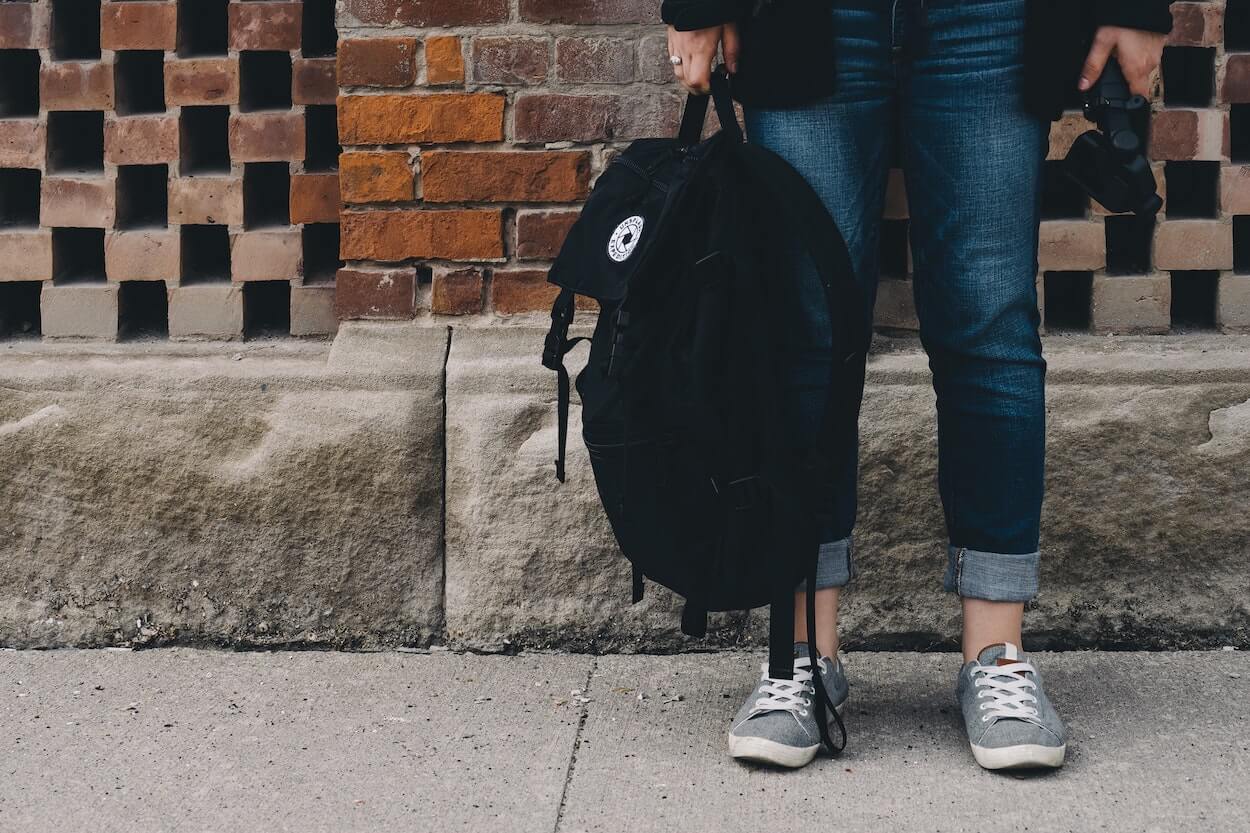
I believe a backpack makes for better travel.
A good size for a minimalist travel backpack is in the range 20 to 45 litres. A smaller pack may limit you too much. If you need more capacity, your packing list is probably not focused enough or one bag travel may not be right for your needs on that occasion.
The most important factor to consider with a backpack is fit. One size does not fit all. Too many people buy a pack that doesn’t fit their torso. You need to try on different packs with load. You also need to make sure you wear the backpack correctly as often it sits too low on the back and this can cause discomfort. Shoulder straps are also important to consider for fit and comfort. Are they adjustable, padded and durable? Some backpacks come with a sternum strap and hip belt. These are great if you intend to carry for long periods, but can otherwise add unnecessary bulk and weight to your pack. Check if these accessories can be removed or added if they aren’t standard.
Which backpack should you get? It depends. You need to decide what you value and need. Do you need a separate laptop compartment, internal pockets, waterproof fabric? Be sensible and don’t decide on a backpack based only on aesthetics.
Suggestions:
GORUCK GR1 or GORUCK GR2. The GORUCK comes in two models and four sizes (GR1: 21L and 26L, GR2: 34L and 40L). You also have the option to add a sternum strap and hip belt. The rucks are durable and GORUCK offer a lifetime guarantee on repairs. The rucks have internal and external pockets, padded straps as well as a separate laptop compartment. The GORUCK rucks are almost ideal for one bag travel, but they are not lightweight and the material can be abrasive.
Other backpacks to consider are Arcteryx Blade 28 (28L), eBags TLS Mother Lode Weekender Convertible, Minaal Carry-on 2.0, Osprey Farpoint series (40-80L), Osprey Porter series (46L/65L), Red Oxx Sky Train (38L), Tom Bihn Smart Alec (26L), Tom Bihn Synapse 25 (25L), Cotopaxi Allpa Travel Pack, Peak Design Travel Line Backpack, and the Tortuga Outbreaker Backpack (35L/45L).
Other brands to consider are Maxpedition, Mystery Ranch and Triple Aught Design for military/tactical style backpacks. If you are interested in a hiking hybrid backpack, consider the Tom Bihn The Hero's Journey.
Shoulder and carry-on bags with spinners
Alternatives to the backpack include a shoulder bag (also known as a kit bag or messenger bag) and carry-on bags with spinners.
The shoulder bag is my preferred option for one bag travel if I don’t use a backpack.
A shoulder bag is similar to a duffel bag with a large compartment for ease of access. It also shares many of the benefits of a backpack. As with a backpack, the most important factor to consider is fit. In addition to the shoulder strap, some shoulder bags come with backpack straps, carry and end grab handles. If you plan to carry your bag for long periods, a backpack is the better option, as the uneven weight distribution and lack of back support will wear and tear on your body in the long run. Make sure the carrying strap is adjustable.
Carry-on bags with spinners are often down-sized versions of the checked bags I discussed earlier. They share the same characteristics.
Patagonia Black Hole MLC
A soft-sided bag that converts to a backpack or a shoulder bag. It's made with 100% recycled fabric, lining and webbing.
Buy on AmazonSuggestions:
GORUCK Kit Bag (32L). The GORUCK Kit Bag is similar to the GORUCK GR1 and GR2, but has fewer features and is more lightweight. A padded shoulder strap is not included, but can be bought separately.
Other shoulder bags to consider are Arcteryx Covert Case (40L), Patagonia Black Hole MLC (45L), and Tom Bihn Aeronaut (30L/45L).
Brands to consider if you are interested in a carry-on bag with spinners include: Briggs & Riley, Rimowa, Samsonite, and Tumi.
Daypacks
A daypack that fits within your carry-on or checked bag can be a useful addition to your packing list. At your destination, use the daypack for any activity that involves more gear than you can carry in your pockets. A daypack is also a safeguard if you are required to check-in your carry-on bag at the airport. Remove your daypack, and only pack what you don’t want to check-in.
A good size for a daypack is in the range of 10 to 15 litres. You can also use a daypack for more than travel, such as for everyday carry. A daypack shares the same characteristics as a backpack.
Suggestions:
Fjällräven Kånken (16L). Iconic Swedish design that has been around since 1978. GORUCK Bullet Ruck (10L and 15L). A smaller, streamlined and simpler version of the GORUCK GR1 ruck. Sea to Summit Ultra-SIL Day Pack (20L), Osprey Ultralight Stuff Pack, Tom Bihn Daylight Backpack (16L), and the Topo Designs Trip Pack.
Travel accessories
In addition to your bag of choice, some accessories can make travel more convenient, but they’re not essential. These include packing organisers, dry bags, a toiletry bag, a travel document organiser, and backpack rain cover.
Packing organisers help you organise your stuff and make it easier for you to pack, find, and access items in your bag. Use packing organisers for clothes, shoes, and gear. Packing organisers are functional items and can also be used for toiletries and around the home. A packing organiser with a carrying handle can be used as a bag or pouch on its own. You can use packing organisers inside all sorts of bags, including in a backpack and daypack.
Packing organisers come in a range of sizes and models. For most use cases, I suggest you look at small and medium-sized packing organisers, not large, as these will be the most versatile. As an example, if you only travel with a daypack you will have more use of a small packing organiser than a large one that may not fit. Packing organisers come as packing cubes, packing folders, packing compression, shoe bags, and more.
Many of the brands I’ve covered in the Travel Bags section, such as GORUCK and Tom Bihn, also offer packing organisers.
Brands to consider are Eagle Creek travel cubes, eBags packing cubes, and Sea to Summit packing cubes.
In addition to packing organisers, you may want to look at a dry sack if you need to keep your stuff waterproof. A dry sack is also multifunctional. You can use it to organise your stuff or as a laundry bag. A toiletry bag may be of interest, but a packing organiser can be used for the same purpose. A dedicated travel holder for your travel documents and passport is a good idea. If you travel with a backpack, it may be worthwhile to look at a rain cover. The cover will prevent your pack’s exterior and interior from getting wet and absorbing rain.
Suggestions:
Arcteryx Pack Shelter, Osprey Backpack Covers, and the Sea to Summit Pack Covers.
Clothing
There are several factors to consider before you decide what clothing to pack. These include:
- Colour;
- Comfort and fit;
- Functionality;
- Material; and
- Weight.
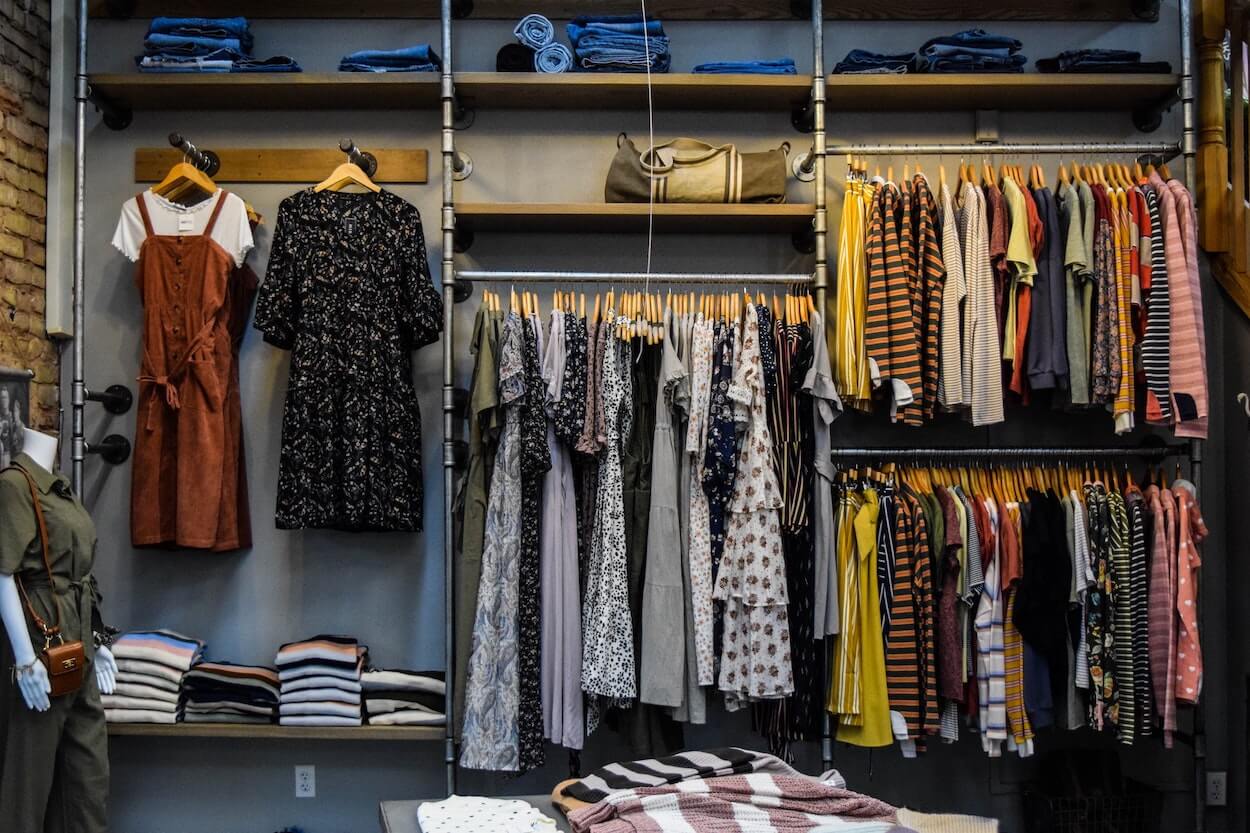
Merino is seen as one of the best fabrics for travel. It’s a functional fabric and can be worn throughout the year. Merino is comfortable, lightweight, durable, odour-resistant, breathable, and moisture-wicking. The fabric provides natural heating and cooling, is easy to wash and dries quickly. Merino can be worn for days without looking dirty, and with proper care can last many years.
Unfortunately, merino is expensive, and although it’s a durable fabric, it will naturally pile. The quality of the merino fabric is important, but even high-quality merino will pile and may develop holes after a fair amount of use.
Other materials to consider are synthetic fabrics. Synthetic fabrics share many of the same properties as merino, but aren’t as breathable and tend to develop odour quickly. They’re more affordable and durable. Cotton is fine, but it doesn’t have the same breathability, odour-resistance, and quick drying properties as merino and synthetic fabrics.
Pack clothes you can use in different settings, such as a pair of shorts that you can use at the beach, gym or around town. The same applies to shoes. You should also think in terms of layers. Layers offer more flexibility in unpredictable and cold weather compared to heavy duty clothing. Basic layering consists of a base layer, mid-layer, and outer-layer. Functional clothing and layering will help you pack fewer items without limiting your clothing options.
Dark-coloured clothes are generally more convenient for minimalist travel. They’re easier to mix and match to create different outfits for both casual and formal settings, and they hide dirt and sweat better than light-coloured ones.
Comfort and fit should override the factors outlined above. If you don’t like or feel comfortable in an article of clothing, you will not use it even if it’s deemed ideal for travel.
Many of the brands I feature here for minimalist travel are expensive, but with care, they can last many years. But at the end of the day, it’s just clothing. Sometimes the best travel gear is what you already own. Don’t make it more complicated than it needs to be.
Underwear
Arguably, the base layer is the most important as you wear it next to your skin. Underwear needs to be comfortable, breathable, and moisture-wicking. Underwear should also be easy to wash and quick to dry.
Suggestions:
Arcteryx Phase SL Boxer Short, ExOfficio Give-N-Go Boxer Briefs, Icebreaker Anatomica Boxers, Smartwool Boxer Brief, Under Armour Underwear, and the UNIQLO AIRism Boxer Briefs.
Brands to consider for cold climates are Icebreaker thermal underwear, Patagonia thermal underwear, and Smartwool thermal underwear.
Socks
There are two kinds of socks to consider: regular and compression socks.
The most important factor with socks is fit. Thereafter, consider the other factors outlined in the Clothing section. Crew is probably the most practical sock length for use throughout the year.
Darn Tough
Purpose built premium merino wool socks made in Vermont, USA. Lifetime guarantee.
Buy on AmazonBrands to consider are Darn Tough (lifetime guarantee), and Smartwool socks.
Compression socks are great for long-haul flights as compression of the lower leg increases blood flow. This helps your legs feel better. There’s also scientific evidence that suggests compression socks can help prevent leg swelling during travel. This reduces the risk of blood clots in the legs, which is known as deep vein thrombosis.
Suggestions:
2XU Compression Socks, CEP Recovery+, and the Smartwool StandUP Graduated Compression Socks.
T-Shirts
A t-shirt for minimalist travel should be functional and work in different settings, such as around town and at the gym.
Suggestions:
Arcteryx A2B T-Shirt, Outlier Ultrafine Merino T-Shirts, Icebreaker Tech Lite Short Sleeve Crewe, Patagonia Capilene Cool Daily Shirt, Smartwool Merino 150 Base Layer Short Sleeve, and the Wool&Prince Merino Wool Crew Neck T-Shirt.
Shirts
The shirt is one of the most functional pieces of clothing. You can use a shirt in casual and formal settings, and wear it for extended periods while still looking fresh.
Opt for a long-sleeved shirt and roll up the sleeves when desired to get the most out of the shirt.
Arcteryx Elaho Shirt LS
A lightweight long sleeve shirt for hiking, travel, and casual wear.
Buy on AmazonSuggestions:
Outlier Shirts, Wool&Prince Merino Wool Button-Down Shirts, Arcteryx Elaho Shirt LS, Bluffworks The Meridian 2.0, and the Icebreaker Merino Steveston Long Sleeve Flannel Shirt.
Shorts
Shorts can be functional. You can use a pair of shorts as swimwear, for exercise, and in casual and formal settings.
Olivers Apparel All Over Short
A short designed with two things in mind: performance and style.
Buy on AmazonSuggestions:
Myles Apparel Everyday Short, Patagonia Shorts, Orlebar Brown Bulldog Short, Olivers Apparel All Over Short, and the Outlier New Way Shorts.
Pants
An alternative to jeans is a technical pant. A technical pant is comfortable and breathable as well as odour and dirt resistant, lightweight, durable, and can be used in different settings.
Suggestions:
Bluffworks Original and Bluffworks Chino, Mission Workshop The Mission Jean, prAna Brion Pant, and Outlier Slim Dungarees.
Sweaters and jackets
Keep your mid and outer-layers lightweight. Your mid-layer can be a hoodie, sweatshirt, henley, or pullover. Remember to wear your mid and outer-layers when you travel to save space in your pack.
Arcteryx Atom LT Hoody
A versatile insulated hoody that excels as a midlayer or standalone.
Buy on AmazonSuggestions:
Arcteryx Atom LT Hoody and Arcteryx Beta LT Jacket, Patagonia Nano Puff, Patagonia Torrentshell Jacket, and the Marmot Minimalist Jacket.
Shoes
Travel in shoes that are comfortable and functional. An example is an athletic shoe or sneaker that can be used around town and at the gym. If you need hiking boots or similar shoes wear these during travel to save space in your pack.
Brands to consider are Arcteryx Shoes, Merrell Shoes, New Balance Shoes, Nike Shoes, Xero Shoes, and Vivobarefoot.
You don’t need that many shoes. Apart from the shoes you wear during travel, a pair of flip-flops is usually enough.
Suggestions:
Havaianas, LUNA Sandals, OluKai Sandals, Reef Classic Sandals, Teva Sandals, and Xero Shoes.
Accessories
I consider Buff Headwear to be an essential part of a packing list, and everyday carry. Buff provides multifunctional headwear that you can wear in at least 12 different ways. It can be used during the flight as a neck gaiter if it’s cold or a sleep mask. Other uses include a hat, helmet liner, and hairband.
Packing list
How much clothing should you pack? It depends.
I’ve created an example packing list below that you can use as a guide. Use it as such and modify it to fit your needs. The clothing you’ll wear during travel is included in the list.
- Underwear: 3-5
- Socks: 3-5
- T-shirts: 2-4 (includes a t-shirt that you can use for exercise)
- Shirts: 1-3
- Sweaters: 1-2
- Shorts: 1-2 (includes a pair of shorts that you can use as swimwear and exercise)
- Pants: 1-3
- Jacket: 1-2
- Shoes: 1-3
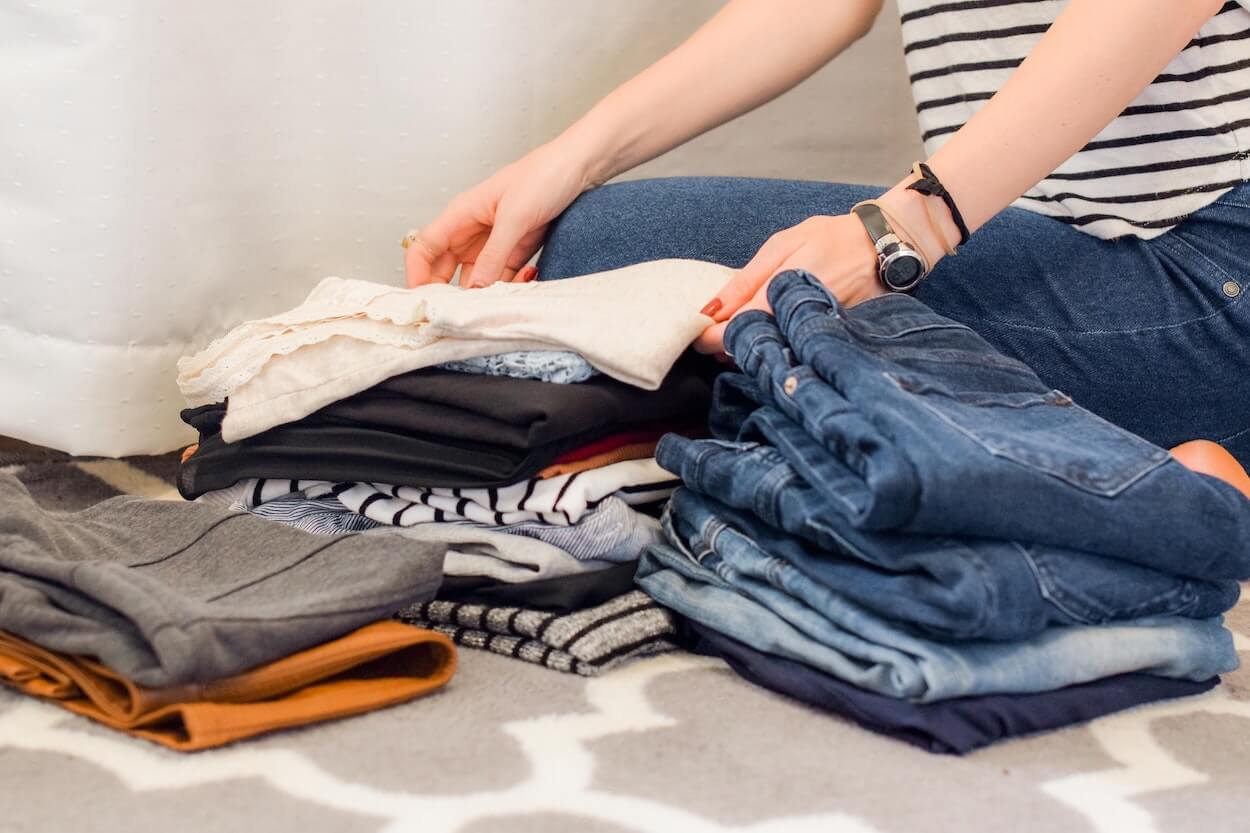
It's OK to wing it. Just get on the plane and go. You can pick up a nicer shirt, shaving cream, and a toothbrush once you get there.
Gear
The last part to consider is what gear to pack. If you travel for pleasure, I suggest you leave most of your electronic devices at home. This will make for better travel.

Smartphone
A smartphone, such as an Android or Apple iPhone. A smartphone will also provide you with a camera, flashlight and reading device.
Apple iPhone 14 Pro Max
Apple iPhone 14 Pro Max comes in 4 colors in 128GB, 256GB, 512GB & 1TB memory.
Buy on AmazonLaptop
A laptop, such as the Apple MacBook Air, Apple MacBook Pro, Microsoft Surface, or a Chromebook, such as the Google Pixelbook Go.
Laptop accessories
A laptop stand, such as the Roost Laptop Stand. The Roost laptop stand is compact, lightweight and portable. An external keyboard, such as the Apple Magic Keyboard, and mouse, such as the Apple Magic Trackpad.
Roost Laptop Stand
An ultra-portable, lightweight laptop stand that transforms your laptop into an ergonomic desktop workstation.
Buy on AmazonCamera
For compact point-and-shoot cameras consider the Sony Cyber-shot DSC-RX100 VII, Panasonic Lumix DC-ZS200, Ricoh GR III, Canon EOS M200 and Olympus Tough TG-6.
For an action camera consider a GoPro.
Camera accessories
A tripod for your smartphone and camera, such as the JOBY GorillaPod or Manfrotto PIXI, and a Peak Design camera clip for carrying your camera.
Power
A portable charger is useful for everyday carry and travel. Avoid the need to constantly look for a power outlet. You’ll need to consider the tradeoff between portability and capacity. The more capacity you need, the greater the size and weight of the charger. Consider the Anker PowerCore+ mini 3350, Anker PowerCore 10000 PD, Anker PowerCore Fusion, and Mophie Powerstation.
Storage
An external and portable hard drive for backup and storage. The LaCie Rugged offers protection to the hard drive, but is bulky. Lightweight options include the Samsung Portable SSD T5, Seagate Backup Plus Slim, Seagate Backup Plus and the Western Digital My Passport.
e-Book reader
An e-book reader, such as the Amazon Kindle, Nook or Kobo Forma. There are three different Kindle models. The Kindle Paperwhite is Amazon’s bestseller.
Click here for a list of book recommendations.
Headphones
There are many different headphone types to consider such as wireless, in-ear, on-ear, over-ear and noise cancelling. Beware that some headphones leak sound and therefore aren’t appropriate in all settings. Headphones to consider include: Bose Noise Cancelling Headphones 700, Bose QuietComfort 35 II, Sony WH-1000XM3, Grado SR80e, Apple AirPods Pro, Shure SE425 and Bang and Olufsen Beoplay H3.
Adapter plugs
You may need an adapter plug to charge your electronics when you travel abroad. An adapter plug makes it possible for you to plug your device into different types of power outlets. Note, an adapter plug doesn’t convert electrical output current and voltage. Check your device’s label to determine if you also need a voltage converter.
Flashlight
A flashlight, such as a SureFire, or headlamp, such as a Petzel. Although your smartphone has a built-in flashlight, there are situations where a standalone flashlight is better.
Ear plugs
Ear plugs to reduce noise during travel.
Pen and notepad
A pen and notepad, such as the Fisher Space Pen Bullet and Field Notes, to use for journaling and note taking.
Carabiner, paracord and rubber bands
A carabiner, some paracord and rubber bands.
The use of these items will surprise you and often you will not know you need them until you do. They’re multifunctional. You can use a carabiner to attach gear to your backpack, such as a pair of shoes or a water bottle. And you can use paracord can to string a clothesline, keep items rolled up, secure a tent, replace frayed shoelaces, etc. You can also use rubber bands as a hair tie, wallet, bag sealer, wrist strap for your camera, etc.
Towel
A towel that is compact, lightweight and quick drying such as the Rainleaf Microfiber Towel, Sea to Summit Drylite Towel, and The Friendly Swede Microfiber Towel.

Stuff your eyes with wonder, live as if you'd drop dead in ten seconds. See the world. It's more fantastic than any dream made or paid for in factories. Ask no guarantees, ask for no security, there never was such an animal. And if there were, it would be related to the great sloth which hangs upside down in a tree all day every day, sleeping its life away. To hell with that, shake the tree and knock the great sloth down on his ass.


















































